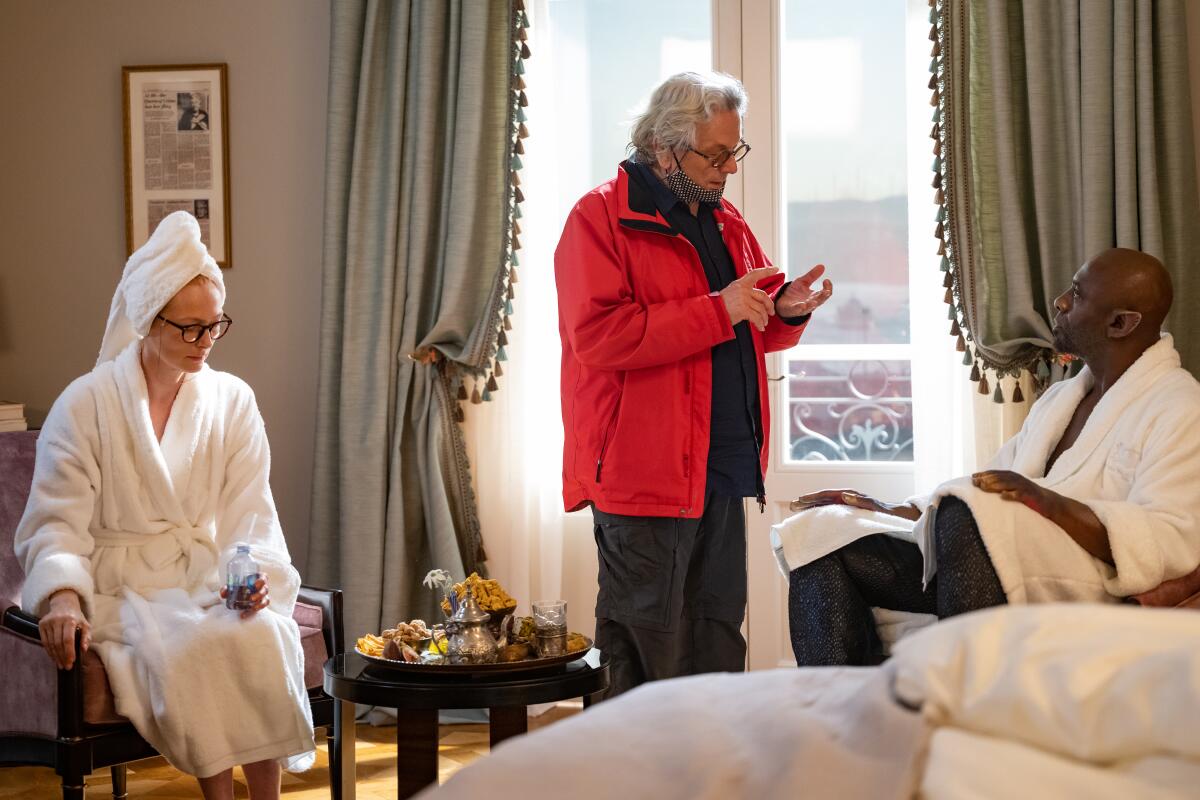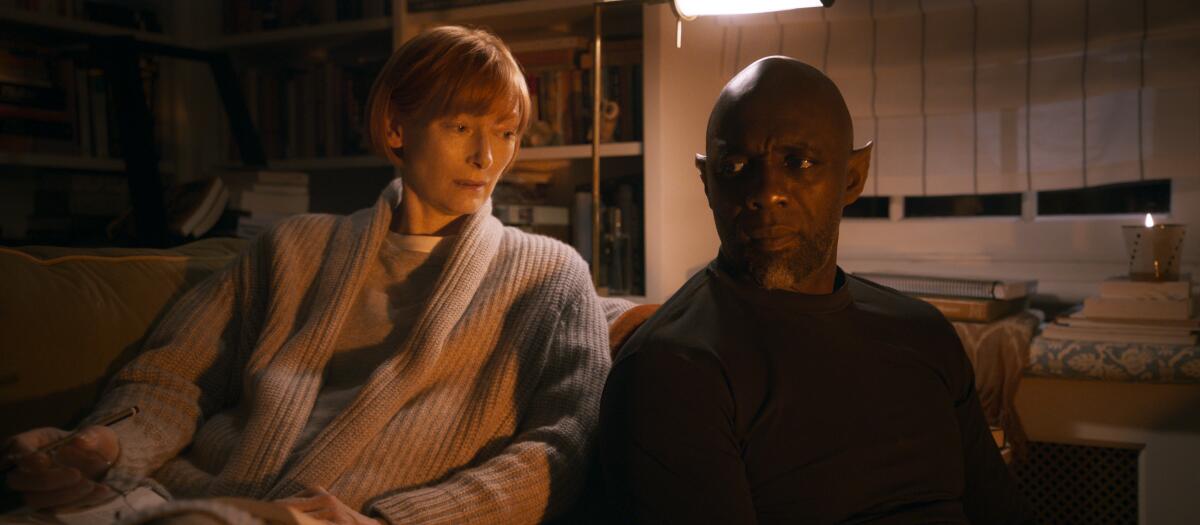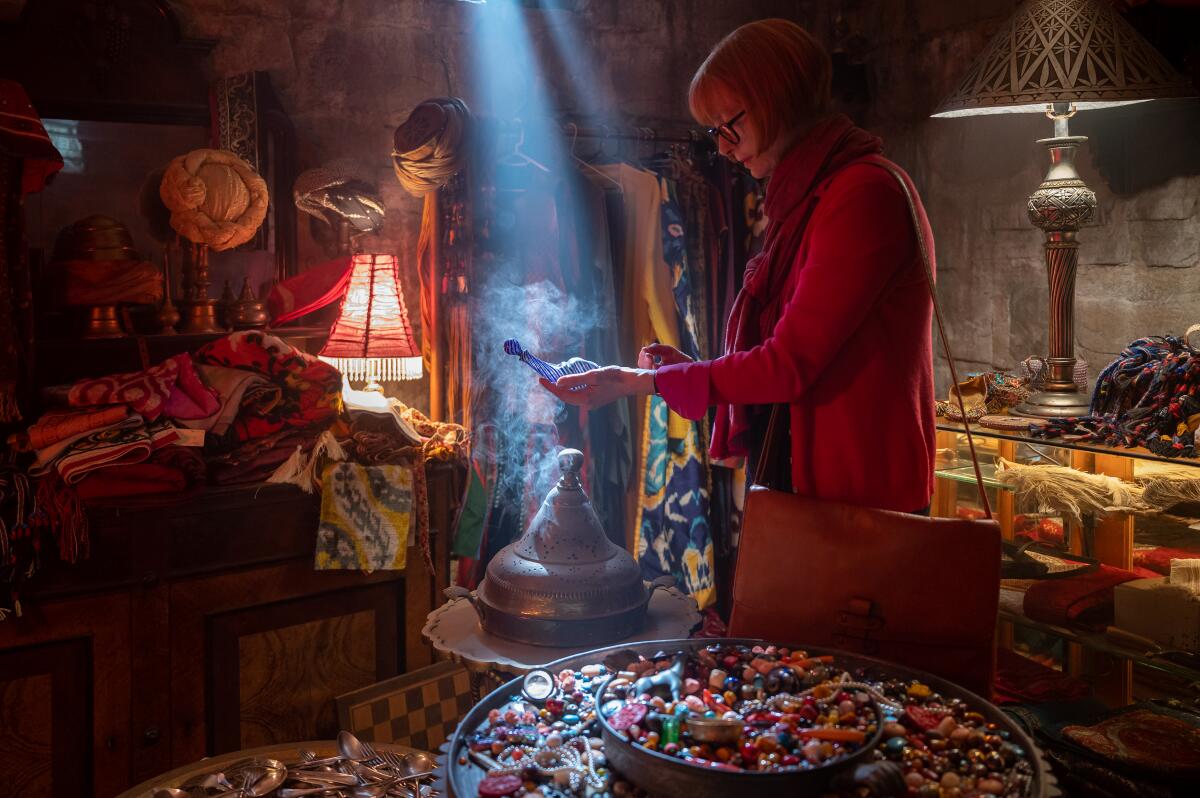George Miller on making every film unique, from ‘Furiosa’ to ‘Three Thousand Years of Longing’

- Share via
As the follow-up to his groundbreaking “Mad Max: Fury Road,” the high-energy desert chase action movie that won six Oscars, Australian filmmaker George Miller is set to surprise audiences again with “Three Thousand Years of Longing.”
The film, which opens nationwide Friday, is adapted by Miller and his daughter Augusta Gore from A.S. Byatt’s 1994 short story “The Djinn in the Nightingale’s Eye.” Tilda Swinton plays Alithea Binnie, a narratologist (she studies storytelling) who has traveled from her home in London to a conference in Istanbul. There she encounters a Djinn (Idris Elba), a magical being who tells her of his encounters across millennia. She is reluctant to use his power to grant her wishes, further complicating their dynamic.
For a recent interview, Miller was on a video call from his home in Sydney, Australia, where he was deep into production on the anticipated “Fury Road” prequel “Furiosa,” in which Anya Taylor-Joy takes over the role originated by Charlize Theron. Making one movie while promoting another leads to the occasional confusion, such as when Miller accidentally referred to the main character of one movie by the name of the other.
“Sorry, I always mix up names, calling Alithea Furiosa,” Miller said with a laugh. “As we were shooting one film, I would sometimes call Furiosa Alithea.”
There has been something elemental about many of Miller’s films, from the “Mad Max” series to his “Babe” and “Happy Feet” movies, including a long-standing interest in how stories are told and retold. So it makes sense that he should adapt a story such as “Three Thousand Years,” which has the art and meaning of storytelling as its very core.
“We fashion stories out of everything. We’re looking for signal in the noise,” said Miller. “And some of our stories are delusional. Some of our stories are nourishing and healing. And some of our stories are very, very toxic. But whatever it is, that’s the only way we can negotiate this thing we call experience and existence. So it’s very, very central to who we are.”

Given the success of “Fury Road,” do you feel pressure to somehow top yourself with “Furiosa,” to make something even bigger and wilder?
It’s not a question I’ve really asked myself. You’re striving to make each film better but not necessarily more. You’re not looking for more, you’re looking for it to be as good as it can be. You’re definitely looking to not repeat what you’ve just done and you are looking to make it, if you like, uniquely familiar. It’s got to be its own thing.
After I made the first “Mad Max” all those years ago, I didn’t want to make another “Mad Max” film. Then I made a second one. And for me, personally, it was on the condition that I was able to overcome all the mistakes that I thought I learned from the first film. So the second film had to be different from the first. So it was a different film in tone, in style and everything. The only thing really in common was that it was Mel Gibson. The third film, the same, and that was “Thunderdome.” They had to be different.
Otherwise we were just repeating ourselves. And then I remember on “Fury Road,” that had to be different again. People were saying, “Oh, can you make it like ‘Road Warrior’? ‘Road Warrior’ was really the best of those films.” And I thought, “Well, wait a minute, that was 30 years ago. Everything’s changed. Not only have I changed personally, the world’s changed. Cinema has changed, the way we read cinema has changed, the way we make cinema’s changed. If we were just to go back and I’m doing a remake of that film, we’d be fools.” So it had to be different. [“Furiosa”] is the first one which had to allude to a previous film, to ”Fury Road” in its design, in its characters, in its world, because it was a prequel. And so we were much more rigorous in that regard.
“Three Thousand Years of Longing” is very much a story about storytelling. Is that what appealed to you in the original short story?
Very, very much. That’s certainly at the heart of it. It’s about story and how story creates meaning for us and how those meanings are often about the really big questions or issues of our existence: what is real; what is not real; that dichotomy between a character who’s a creature of reason, Alithea, Tilda’s character, and a creature driven by emotion and desires and passion. You get the notion of a character who is mortal, like the rest of us, and someone who is ostensibly immortal, to live indefinitely. You get the notion of love, desire, all those things. And most of all you get a story about stories, someone telling stories within stories but also really trying to understand what’s the function of stories. Why are we hard-wired to tell each other stories?
And here is someone, I’m talking about A.S. Byatt herself, she’s a literary figure, but she’s also a scholar who really is interested in why we tell stories and how stories evolve all the time. And I found that issue really resonated with me. So, yes, it’s really interesting to be trying to make a film which is about the telling of stories as much as anything else.

The film deals with Middle Eastern culture and ancient cultures. As you were writing the screenplay and also working on the production, say in the design and casting, were you concerned about issues of cultural appropriation or what people would call Orientalism? That you not be exoticizing or making “other” these foreign cultures? How did you grapple with the cultural elements of the story?
Well, that’s always an issue. When you go back to the time of Sheba, there’s no historical record of Sheba. Depending on which culture you go to, some people say she’s from Eritrea, other people say she’s from Ethiopia and others from some parts of northern Africa, but no one really knows. It’s in the biblical stories in the Old Testament that Sheba goes to visit Solomon — I’m not even sure if it’s in the Bible, but it’s in the religious stories — and as the Djinn tells the story, Alithea says, “Wait a moment. Didn’t Sheba go to Solomon?” And he says, “No, he came to her.” And she says, “But it’s in all the holy books.” And he says, “No, Madam, I was there.” So we basically alerted ourselves that this was the Djinn’s interpretation of the story on the one hand. And on the other hand, it was very much Alithea’s imagining of the story. We were inviting the audience to hear the story from the Djinn through the eyes of Alithea.
Now when we get into the stories of the Ottoman Empire, they’re based much more on the historical fact. So obviously the designs of the story, it’s much more known. And then we go to 19th century Istanbul and so into modern day. So we’re telling the Djinn’s version as perceived by Alithea.
A.S. Byatt, she’s particularly interested in the cultural evolution of stories. And she pointed out how we did refashion those stories and appropriate them into European culture. Now that’s common throughout all of mankind as we get into the monomyth that Joseph Campbell basically elucidated, that those stories in one form or another are shared across humankind, it’s kind of a monoculture. And we see it now manifests as information is disseminated so quickly all over the world. So there was no problem of mixing cultures. They sat as part of the cultural evolution. One was not negating the other is what I’m saying. So that’s my way of explaining how Alithea is interpreting the stories on our behalf through her experience. And that’s the way I would explain the way we dealt with cultures. Whether people want to call it cultural appropriation, it’s up to their judgment.
People know you for the “Mad Max” films, the “Babe” pictures, “Happy Feet,” but then you have this other strain of movie that people sometimes forget that you made, like “The Witches of Eastwick” or “Lorenzo’s Oil.” And I’m wondering how you see “Three Thousand Years of Longing” fitting into your filmography. Is it going to be one of the ones that’s hard for people to recognize as a George Miller movie?
It’s something I haven’t really given much thought to, except to say I’m driven by the story itself, whether the story comes to mind and kind of germinates over time or whether it’s something like “Lorenzo’s Oil,” which I first read as a newspaper article and saw something in the story. When I first read the book [“Babe”] by Dick King-Smith, at the time it was called “The Sheep-Pig,” the story gets hold of you. You feel its gravitational pull, that’s the first thing. But then the second thing, it always needs something — it’s a secondary concern but it’s an important concern — which is basically moving with the technology as it evolves in cinema.
For instance, going back to “Babe,” we had written that story about a good five or six years before it was possible to make it in the way that it made the most sense. We wanted animals to talk, but we wanted to make it as real as possible. And it was just at the beginning of the ’90s when the early digital work done at ILM started to emerge. And you actually had the firepower to do it. When Andrew Lesnie, who shot the “Babe” movies, shot the first of the “Lord of the Rings” in the early 2000s, he showed the first motion capture with Gollum. And I remember I had the story of the penguins for “Happy Feet” and I thought, “Ah, the penguins can dance.” We don’t have to rely on the animators to be good dancers. We can get real dancers, we can get Savion Glover to play a virtuoso tap dancer. And so that goes hand in hand.
By the time we got to do “Fury Road,” it was a whole new world, filmmaking. You could use multiple cameras and you didn’t have to worry about starting a shot and only having 10 minutes before the magazine of celluloid ran out. And most of all you could harness all your stuntmen, you could harness your actors — when Tom Hardy hangs upside down between the wheels of a vehicle, that was Tom Hardy as safe as possible because he had harnesses and cables, and you could erase them. It sounds simple, but you can drive vehicles across the desert and erase all the tracks beforehand. Otherwise you’d have to keep moving across the desert. All of that sort of thing was a very interesting thing to do, an action movie first driven by story but then using the technology. And that is the inherent richness of the story. There has to be much more to a story than meets the eye.
I would say that when you are looking to make a film — I’m not saying this is what happens, but this is the aspiration — you’re looking to make a film that engages the whole of the human being. By that I mean it must work viscerally. It must get you in your gut. It must get you emotionally in your heart. It must get you in your mind and your intellect. It must get you in terms of the collective, the thing that you recognize in yourself as being part of some larger human experience, and we could call that the mythological or the spiritual. It must do all of that at the same time. That’s the hope.
And that applies to every story. Every great sporting story hits those patterns. Every fairy tale you tell your children has to hit those. That’s why they’re the ones that endure. So more and more that becomes more conscious in my thinking.
More to Read
Only good movies
Get the Indie Focus newsletter, Mark Olsen's weekly guide to the world of cinema.
You may occasionally receive promotional content from the Los Angeles Times.











